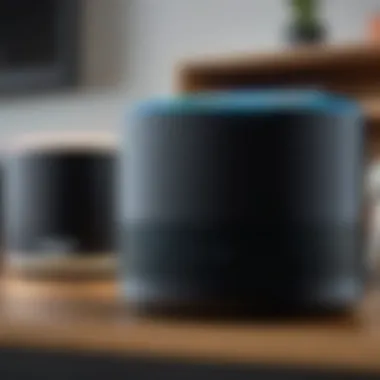Use Your Phone for Seamless Alexa Control


Intro
In the digital age, the evolution of technology continues to reshape our expectations and interactions with devices. One notable advancement is the ability to use your smartphone as a remote for voice assistants like Amazon Alexa. This adaptation not only brings convenience but elevates the user experience by leveraging existing technology. In this article, we will explore the necessary applications, connectivity options, and various features of the Alexa app to transform your smartphone into a streamlined remote control. By utilising both Android and iOS platforms, we aim to provide a holistic understanding of how to fully integrate Alexa's functionalities into your everyday life.
Overview of the Technology
Using a smartphone as a remote for Alexa requires a solid understanding of both the software and hardware behind the technology.
Key specifications
- Compatibility: Most modern smartphones running on Android 5.0 or iOS 10.0 and above can use the Alexa app efficiently.
- Connectivity: The primary method of integration is through Wi-Fi or Bluetooth, ensuring a stable connection with Alexa-enabled devices.
- Voice Recognition: Modern models of smartphones boast advanced microphones designed for clear voice recognition, enhancing the interaction with Alexa.
Unique selling points
- Versatility: Smartphones not only control Alexa devices but can access a wide array of apps and smart home functionalities, centralising control at your fingertips.
- Portability: Unlike traditional remotes, smartphones are always with us, making them highly convenient for quick commands and adjustments in a smart home environment.
Getting Started with the Alexa App
Before you can wield your smartphone as a remote control for Alexa, you need to set up the required applications and ensure proper connectivity. Here are the necessary steps:
- Download the Alexa App: Available on both Google Play Store and Apple App Store, ensure you have the latest version installed.
- Sign In or Create an Amazon Account: If you don’t have one, follow the guided steps to create an account. This account is necessary for Alexa's functionality.
- Connect to Wi-Fi: Make sure your smartphone and Alexa-enabled devices are connected to the same Wi-Fi network for seamless communication.
Using your smartphone as a remote for Alexa can enhance your smart home experience manifold, making interactions simpler and more efficient.
Design and Build Quality
When considering a smartphone for remote use, design and build quality play a crucial role. While most smartphones today offer user-friendly designs, several features are worth noting for optimal use as an Alexa remote.
Material used
- Many modern smartphones utilize durable and lightweight materials, enhancing ease of use for extended periods. Materials can include aluminum and glass, which contribute to a premium feel and handling.
Ergonomics and usability
- Display Size: Smartphones with larger displays allow for easier navigation within the Alexa app, presenting information clearly.
- Button Placement: Intuitive button placement enables quick access to voice commands and app functionalities.
By comprehensively understanding your smartphone's capabilities, you can unlock a myriad of functionalities within the Alexa ecosystem, enhancing the overall user experience.
Stay with us as we delve deeper into advanced features of the Alexa app and practical troubleshooting tips that will maximize your integration journey.
Prelude to Alexa and Remote Technology
The integration of smartphones with voice assistants like Amazon Alexa has transformed how we interact with technology in our daily lives. This section is essential in our exploration of mobile devices serving as remote controls for Alexa, highlighting the advantages and challenges of such systems.
Overview of Amazon Alexa
Amazon Alexa is a cloud-based voice service that provides various functionalities, from making calls to controlling smart home devices. The appeal lies in its ability to perform tasks with simple voice commands, making technology more accessible. The Alexa ecosystem comprises various compatible devices, but the smartphone app is particularly impactful. It allows users to harness Alexa's capabilities when they are not near a dedicated Alexa device. With the app, users can customize settings, manage smart devices, and leverage voice-first technology on the go.
Evolution of Remote Control Technology
Remote control technology has evolved dramatically over the years. Traditionally, remotes were limited to controlling devices within a short range using infrared signals. However, with advancements in wireless technology, users can now communicate with devices through Wi-Fi or Bluetooth regardless of their location within the home.


Here is a brief timeline of important milestones in remote control technology:
- Early 1900s: Development of remote controls for various applications, often using wired connections.
- 1950s: The invention of the first wireless remote controls, initially for television sets, using infrared signals.
- 1980s: Introduction of universal remotes that can control multiple devices.
- 2000s and onward: Growth of smart remote technologies with Wi-Fi and Bluetooth capabilities, allowing smartphones to serve as remote controls for a variety of devices.
As users become more accustomed to controlling devices seamlessly from their phones, the evolution continues toward more interconnected environments. The fusion of these technologies enhances user experience, particularly with voice-command systems like Alexa. By understanding this development, readers can appreciate the significance of using their smartphones as Alexa remotes.
Understanding the Alexa Mobile Application
In the context of using your smartphone as a remote for Amazon Alexa, understanding the Alexa mobile application is crucial. This application is the gateway to utilizing the full capabilities of Alexa directly from your phone. It allows users to interact with their smart devices, manage settings, and explore features that would otherwise require physical interactions with an Alexa-enabled device.
The Alexa mobile application is available on both Android and iOS, making it accessible to a wide range of users. It enhances the functionality of Alexa by bringing voice commands, smart home control, and media playbacks to a portable platform. Also, such accessibility fosters a management style that is both efficient and user-friendly, allowing for seamless navigation through voice and touch controls.
Installation Process
Downloading for Android
For Android users, downloading the Alexa app is a straightforward process. The application is available on the Google Play Store, which is the primary source for Android app distribution. The key characteristic of downloading for Android is the wide variety of devices it supports, from budget-friendly phones to the latest models. This makes it a beneficial choice for many, as virtually any smartphone can utilize Alexa's features.
One unique feature of the Android version is its integration with Google services. This allows for apps like Google Photos to be linked, enhancing the usability of Alexa. However, disadvantages can include potential compatibility issues with older devices, which may hinder performance.
Downloading for iOS
For iOS users, accessing the Alexa app involves a similar process, available on the Apple App Store. The key characteristic of downloading for iOS is the seamlessness of integration within the Apple ecosystem. Since iOS has strict guidelines about safety and performance, the app benefits from higher stability and security, making it a popular choice.
iOS version offers features such as integration with Siri, so users can switch between voice assistants easily. On the downside, iOS devices typically require more recent updates for full functionality. Keeping the device updated is essential to take advantage of new app features and improvements.
Initial Setup Configuration
The initial setup configuration of the Alexa app is a critical step in utilizing it as a remote control. Once installed, users must sign in to their Amazon account. This step grants access to all the Alexa features and personal settings.
After signing in, users are prompted to connect their app to their Wi-Fi network. This connection is necessary for effective communication between the mobile device and Alexa-enabled devices. Proper Wi-Fi connection ensures that commands are sent promptly and accurately, maximizing the effectiveness of this remote setup.
Additionally, users may have to configure their smart home devices within the app. This involves adding devices such as lights, cameras, or thermostats. The Alexa app allows for centralized control of these devices, enhancing convenience.
Connecting Your Phone to Alexa
Connecting your phone to Alexa is essential for maximizing the capabilities of your smart assistant. It enables direct communication between your device and the Alexa ecosystem, resulting in a seamless user experience. The integration allows you to manage tasks, control devices, and access information from virtually anywhere. With the right connectivity settings, your smartphone can serve as a powerful remote control for your Alexa-enabled devices.
Wi-Fi Connection Requirements
Wi-Fi connectivity is a fundamental requirement for effective interaction with Alexa. Before getting started, ensure that your phone is connected to a strong Wi-Fi network. This connection is crucial for several reasons:
- Voice Recognition: A stable Wi-Fi connection is needed for Alexa to process your voice commands accurately.
- Device Control: Many smart home devices require an internet connection to function properly. Without Wi-Fi, control over these devices could be limited.
- App Functionality: The Alexa app offers various features that rely on an internet connection, such as streaming music or setting reminders.
To connect your phone:
- Open the Settings app on your mobile device.
- Select Wi-Fi and ensure it is turned on.
- Connect to your home network, entering any necessary passwords.
- Open the Alexa app, which will sync with your Wi-Fi settings automatically.
Bluetooth Pairing Steps
In addition to Wi-Fi, Bluetooth pairing plays a significant role in connecting your phone to Alexa. This feature allows your phone to connect with Alexa-enabled devices without a wired connection. The process is straightforward:
- Activate Bluetooth: Turn on Bluetooth on your mobile device by going to Settings > Bluetooth and toggle it on.
- Open the Alexa App: Launch the Alexa app on your smartphone and navigate to the devices section.
- Add Device: Tap on the option to add a new device. This action prompts Alexa to search for available Bluetooth devices.
- Pairing Process: When your phone appears on the list, select it to establish a connection. You may need to confirm a pairing request.
- Testing the Connection: Once paired, you can issue voice commands, and the audio output will direct through your phone when necessary.


By ensuring both your Wi-Fi and Bluetooth connections are properly set, you can optimize your phone’s functionality as an Alexa remote.
Using the Alexa App as a Remote
Using the Alexa app as a remote opens up a wide range of possibilities for controlling your smart home devices and media playback. It transforms your smartphone into a powerful tool that enhances user experience. This integration of your mobile device and Alexa makes smart living much more efficient and accessible.
The Alexa app serves as a centralized interface for various functions. It simplifies operations compared to physical remotes or voice commands alone. Beyond just issuing commands, the app allows for fine-tuning and personalization of your interactions with devices. This makes it not only useful but essential for a streamlined smart home experience.
Voice Command Features
Voice command features represent a significant part of the Alexa app's functionality. They enable hands-free control over your devices, making life simpler. Users can issue commands simply by speaking. This is especially advantageous when multitasking or when your hands are busy.
For instance, users can say commands like "Alexa, play music" or "Alexa, turn on the lights in the living room." The potential to create custom voice commands further enhances this feature. You can guide Alexa to recognize specific phrases you often use. This minimizes confusion and improves the responsiveness of your interactions.
- Short Commands: For quick operations, concise voice commands work best.
- Custom Commands: Tailoring phrases to fit your preferences is possible, making the device more intuitive.
Controlling Smart Home Devices
The ability to control smart home devices through the Alexa app is another significant feature. This control is both robust and user-friendly. It enables users to operate various products like lights, thermostats, and cameras with minimal steps.
Through just a few taps on the app, users can adjust lighting, check security camera feeds, or change thermostat settings. This feature reduces the need for multiple dedicated remotes and enhances user convenience.
- Device Grouping: Users can group multiple devices under a single command, so that saying "Good Night" can turn off all lights.
- Status Monitoring: Real-time monitoring of device status enhances security and control.
Media Control Functions
Media control functions are another vital aspect of using the Alexa app. The app allows you to control audio and video playback across compatible devices seamlessly. Whether streaming music or videos, the app offers a straightforward interface to manage it all.
With just a few taps, you can select your favorite playlist, adjust the volume, or skip tracks. Certain compatible devices even allow playing videos directly from the app to your TV.
- Streaming Services Compatibility: The Alexa app supports numerous streaming services such as Amazon Music, Spotify, and Netflix, ensuring flexibility in media choices.
- Multi-Room Audio: This feature allows users to play music in multiple rooms simultaneously, creating a unified audio experience.
Using the Alexa app as a remote is not merely a convenience; it transforms the way users interact with technology. The features outlined not only provide operational benefits but also encourage a more integrated smart living experience. By familiarizing yourself with these functionalities, you can optimize how you control and manage your devices.
Advanced Features of the Alexa App
The Alexa app goes beyond basic functionality; it includes advanced features that significantly enhance user interaction with Amazon's smart assistant. Understanding these features is crucial for maximizing the potential of Alexa. The app allows users to automate tasks, streamline their daily routines, and improve productivity.
Creating Routines with Alexa
One of the most powerful aspects of the Alexa app is the ability to create routines. This feature enables users to combine multiple actions into a single command. For instance, you might want to turn off the lights, lock the door, and play music just before going to bed. With routines, this can be achieved with a single voice command or a tap in the app.
To set this up, go to the "Routines" section in the app. Here's a simple process:
- Open the Alexa App: Navigate to the menu and find the Routines option.
- Create New Routine: Tap on the plus sign to start a new routine.
- Set Trigger: Choose how you want to initiate the routine. Options include voice commands, schedules, or even location-based triggers.
- Add Actions: Specify what actions you want Alexa to perform. This can involve controlling smart home devices, providing weather updates, or playing music.
- Save and Test: Once set up, save the routine and test it.
This functionality provides great flexibility, allowing users to tailor their experience according to their habits and preferences. It also saves time and consolidates tasks effectively.
Setting Reminders and To-Do Lists
Another significant aspect of the Alexa app is the ability to set reminders and manage to-do lists. In a fast-paced world, keeping track of daily tasks and important dates is essential.


By utilizing Alexa, users can create reminders for specific times or dates, ensuring they never miss important events. Here’s how to do it:
- Use Voice Command or App: Either ask Alexa to set a reminder or navigate to the appropriate section in the app.
- Specify the Details: When prompted, give the time, date, and the message for the reminder.
- To-Do Lists: To manage your tasks, use similar commands. For example, "Alexa, add milk to my shopping list." You can also view your lists within the app.
This feature aids in maintaining organization in one’s life, offering an intelligent way to troubleshoot forgetfulness.
Using the advanced features within the Alexa app can dramatically enhance your efficiency, making everyday tasks simpler and more manageable.
Incorporating these advanced functionalities into your daily routine can change your interaction with technology, transforming your smartphone into a central hub for all smart home activities. Through effective use of routines and reminders, users can fully harness the capabilities of Amazon Alexa.
Troubleshooting Common Issues
In the journey of utilizing your smartphone as an Alexa remote, various challenges may arise. Understanding these challenges and how to address them is critical for users who wish to enjoy a seamless experience. This section delves into common problems, their implications, and provides clear solutions. Addressing issues related to connectivity and app functionality ensures that users can optimize their device performance and enhance interaction with Alexa.
Connection Problems
Connection problems can arise for many reason. Issues with the Wi-Fi network are usually the culprits. If your smartphone is not connecting to your Alexa device, check the following:
- Wi-Fi Network: Make sure your phone is on the same network as the Alexa device. Check your home network settings or consult your router's manual if unsure.
- Distance: Devices should be close enough to eliminate issues with signal strength. If the distance is too great, the signal may weaken leading to connection drops.
- Restart Devices: Often, a simple restart of both smartphone and Alexa can solve temporary glitches. Unplug the Alexa device for about 30 seconds before plugging back in.
- App Permissions: Ensure that the Alexa app has the necessary wi-fi permissions enabled. This is crucial for connectivity.
If these steps do not resolve the issue, consider checking the device's firmware and the app's compatibility with the current version of your phone’s operating system. Keeping your devices updated is important.
App Malfunctions
App malfunctions can hinder user experience, making it frustrating to utilize Alexa directly from your phone. Here are common issues:
- Crashing: The app may frequently crash, which can be distracting. For this, clear the app's cache by navigating to your phone's settings → Apps → Alexa → Storage → Clear Cache. If the problem persists, reinstall the app to ensure you are on the latest version.
- Login Issues: Sometimes, users may face difficulty logging into their account. Confirm your credentials are correct. Using the forgot password option may also help recover access if necessary.
- Microphone Issues: If voice commands do not work, ensure the microphone has permission and is functioning. It's worth checking if the phone's mute option is activated.
- Performance Lag: If the app is slow or unresponsive, close unused background applications to free up resources. Rebooting the phone also resolves many app-related performance issues.
By being vigilant about these common problems, users can vastly improve their experience when using their smartphones as Alexa remotes. Troubleshooting is not just about fixing. It is about enriching the overall engagement with the technology.
Enhancing User Experience
Enhancing user experience is a crucial aspect of utilizing your smartphone as an Alexa remote. A well-designed experience allows for more effective interactions, increases user satisfaction, and fosters a deeper connection with technology. This section delves into specific elements and benefits that contribute to an improved user experience when using the Alexa app on mobile devices.
One of the primary considerations is intuitive navigation. The Alexa app must provide straightforward access to its features without overwhelming the user. An organized layout helps users quickly find what they need, whether it be controlling smart home devices or accessing media functions. Likewise, clear labels and logical groupings of features facilitate ease of use, reducing the learning curve.
In addition to navigation, personalization plays a significant role. Users appreciate the ability to customize settings to reflect their preferences. By enabling users to save routines or specific commands, the app enhances functionality tailored to individual needs. Furthermore, the app can offer suggestions based on usage patterns, allowing users to discover new features seamlessly.
"The Alexa app should be more than just a control tool; it should become an integral part of the user's daily interactions with technology."
Integrations with third-party applications expand the possibilities for user engagement. Users can enjoy a cohesive experience by linking Alexa with popular apps such as Spotify or Philips Hue. This kind of integration not only demonstrates the versatility of Alexa but also ensures a smoother workflow across multiple platforms.
Moreover, implementing feedback mechanisms can also enrich user experience. Knowing that their inputs help improve app functionalities makes users feel valued. Regular prompts for feedback or a section where users can report issues further engage the audience and drive continuous improvement.
Finally, as technology evolves, keeping the Alexa app updated ensures that users benefit from the latest enhancements. Regular updates not only introduce new features but also improve security and performance. This commitment to staying current provides users with the reassurance that their experience will continually improve and adapt to their changing needs.
In summary, enhancing user experience while using a phone as an Alexa remote involves thoughtful interface design, personalization options, effective integrations, active feedback collection, and maintaining updated software. Each contributes distinctly but collectively improves the way users interact with their smart devices.
Culmination
The significance of viewing smartphones as a remote control for Amazon Alexa cannot be overstated. This perspective opens up new realms of convenience and accessibility for users. By using the Alexa app, individuals can leverage the full potential of their mobile devices, transforming routine tasks into streamlined actions. The discussion throughout this article illuminated various aspects of this integration, highlighting key functionalities and practical applications.
The benefits are clear. Access to voice commands, smart home device control, and media functionalities enhances everyday interactions. It allows users to communicate with Alexa effortlessly from virtually anywhere, thereby increasing efficiency in managing household tasks or enjoying entertainment. In addition, the routine creation and reminder features empower users to establish personalized connections with their smart assistants, leading to a more tailored experience.
Considering the rapidly evolving landscape of technology, the relevance of mobile devices in smart assistant applications will only grow. As new functionalities are introduced in both mobile operating systems and the Alexa app, the potential for deeper integration seems promising. Moreover, adopting this technology can lead to a substantial improvement in the overall user experience. It makes day-to-day operations smoother and more effective.
"Smartphones are no longer just communication tools; they are gateways to a smarter life."
As a user, being proactive about keeping the Alexa app updated and exploring new features can ensure you are taking full advantage of these benefits. The interplay between mobile technology and smart assistants is a trend that will continue to shape how we interact with our homes and devices.







